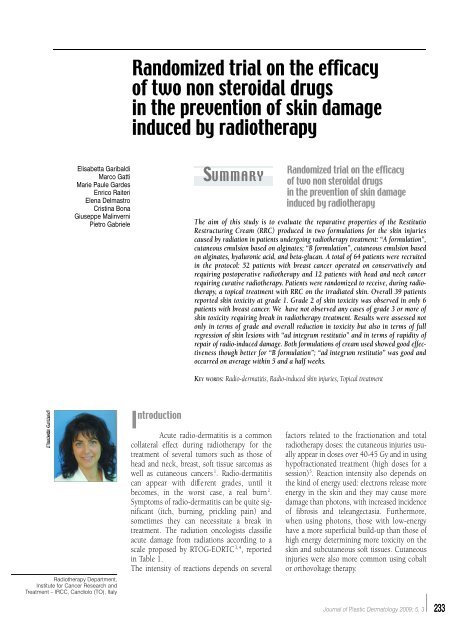Vol. 5, n. 3, September-December 2009 - Salute per tutti
Vol. 5, n. 3, September-December 2009 - Salute per tutti
Vol. 5, n. 3, September-December 2009 - Salute per tutti
You also want an ePaper? Increase the reach of your titles
YUMPU automatically turns print PDFs into web optimized ePapers that Google loves.
Randomized trial on the efficacy<br />
of two non steroidal drugs<br />
in the prevention of skin damage<br />
induced by radiotherapy<br />
Elisabetta Garibaldi<br />
Marco Gatti<br />
Marie Paule Gardes<br />
Enrico Raiteri<br />
Elena Delmastro<br />
Cristina Bona<br />
Giuseppe Malinverni<br />
Pietro Gabriele<br />
SU M M A R Y<br />
Randomized trial on the efficacy<br />
of two non steroidal drugs<br />
in the prevention of skin damage<br />
induced by radiotherapy<br />
The aim of this study is to evaluate the reparative pro<strong>per</strong>ties of the Restitutio<br />
Restructuring Cream (RRC) produced in two formulations for the skin injuries<br />
caused by radiation in patients undergoing radiotherapy treatment: “A formulation”,<br />
cutaneous emulsion based on alginates; “B formulation”, cutaneous emulsion based<br />
on alginates, hyaluronic acid, and beta-glucan. A total of 64 patients were recruited<br />
in the protocol: 52 patients with breast cancer o<strong>per</strong>ated on conservatively and<br />
requiring posto<strong>per</strong>ative radiotherapy and 12 patients with head and neck cancer<br />
requiring curative radiotherapy. Patients were randomized to receive, during radiotherapy,<br />
a topical treatment with RRC on the irradiated skin. Overall 39 patients<br />
reported skin toxicity at grade 1. Grade 2 of skin toxicity was observed in only 6<br />
patients with breast cancer. We have not observed any cases of grade 3 or more of<br />
skin toxicity requiring break in radiotherapy treatment. Results were assessed not<br />
only in terms of grade and overall reduction in toxicity but also in terms of full<br />
regression of skin lesions with “ad integrum restitutio” and in terms of rapidity of<br />
repair of radio-induced damage. Both formulations of cream used showed good effectiveness<br />
though better for “B formulation”; “ad integrum restitutio” was good and<br />
occurred on average within 5 and a half weeks.<br />
KE Y W O R D S: R a d i o - d e rmatitis, Radio-induced skin injuries, Topical tre a t m e n t<br />
Radiotherapy Department,<br />
Institute for Cancer Research and<br />
Treatment – IRCC, Candiolo (TO), Italy<br />
I ntroduction<br />
Acute radio-dermatitis is a common<br />
collateral effect during radiotherapy for the<br />
t reatment of several tumors such as those of<br />
head and neck, breast, soft tissue sarcomas as<br />
well as cutaneous cancers 1 . Radio-dermatitis<br />
can appear with diff e rent grades, until it<br />
becomes, in the worst case, a real burn 2 .<br />
Symptoms of radio-dermatitis can be quite significant<br />
(itch, burning, prickling pain) and<br />
sometimes they can necessitate a break in<br />
t reatment. The radiation oncologists classifie<br />
acute damage from radiations according to a<br />
scale proposed by RT O G - E O RT C 3, 4 , re p o r t e d<br />
in Ta b l e 1.<br />
The intensity of reactions depends on several<br />
factors related to the fractionation and total<br />
radiotherapy doses: the cutaneous injuries usually<br />
appear in doses over 40-45 Gy and in using<br />
hypofractionated treatment (high doses for a<br />
session) 5 . Reaction intensity also depends on<br />
the kind of energy used: electrons release more<br />
energy in the skin and they may cause more<br />
damage than photons, with increased incidence<br />
of fibrosis and teleangectasia. Furthermore ,<br />
when using photons, those with low-energy<br />
have a more su<strong>per</strong>ficial build-up than those of<br />
high energy determining more toxicity on the<br />
skin and subcutaneous soft tissues. Cutaneous<br />
injuries were also more common using cobalt<br />
or orthovoltage therapy.<br />
Journal of Plastic Dermatology <strong>2009</strong>; 5, 3 233

















